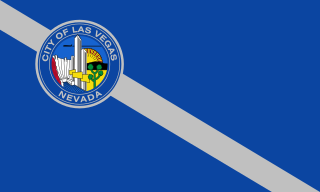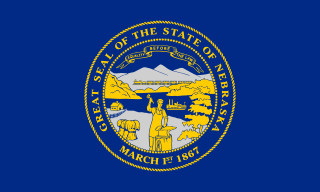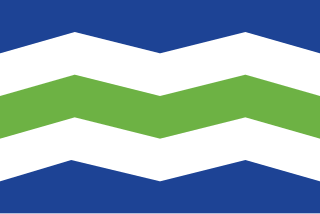
The flag of Missouri, often referred to as the Missouri flag, is the state flag of the U.S. state of Missouri. It consists of a triband of three equal horizontal stripes colored red, white, and blue, with the arms from the Great Seal of Missouri in the center. Designed by Mary Elizabeth Oliver, the red and white stripes represent valor and purity, respectively. The blue stripe represents the permanency, vigilance, and justice of the state. The three colors also highlight the French influence on the state in its early years. The Missouri flag was established on March 22, 1913, when governor Elliot Woolfolk Major signed the State flag act making it official.

The flag of Minnesota is the state flag of the U.S. state of Minnesota. Its design features a modified version of the seal of Minnesota emblazoned on a blue field. The flag's first version was adopted in 1893, in advance of the state's mounting an exhibition at the 1893 Chicago World's Fair. It was significantly revised in 1957 and received a minor update in 1983.

The city flag of Los Angeles consists of a background of three notched stripes of green, gold and red. The flag was designed by Roy E. Silent and E.S. Jones in 1931 for the Los Angeles sesquicentennial from 1781.

The city flag of Portland, Oregon, consists of a green field on which is placed a white four-pointed star from which radiate blue stripes, each bordered by L-shaped yellow elements (esquarres). Narrow white fimbriations separate the blue and yellow elements from each other and from the green background. The official ordinance specifies a height of 3 feet and a length of 5 feet.

The flag of Madison, Wisconsin, includes a sky blue background with a diagonal white stripe that goes from the bottom left corner to the top right which symbolizes Lake Mendota, Lake Monona and the isthmus between them. At the center of the flag is a black cross, which symbolizes the four lakes, as well as the cross shape of the Wisconsin State Capitol. The gold circle in the middle represents the Wisconsin State Capitol's dome.

The flag of Birmingham was designed by Idyl King Sorsby for the occasion of the semicentennial of the city of Birmingham, Alabama in 1921. The flag was officially adopted as the city's flag on August 18, 1925.

The city flag of Philadelphia is a blue and yellow triband, featuring the Seal of Philadelphia.

The flag of Denver is the official flag of the City and County of Denver in Colorado. It was designed by a North High School student, Margaret Overbeck, and adopted in 1926. A zigzag white stripe horizontally separates a red field below from a blue field above, in which is centered a yellow circle, together forming a stylized depiction of the Sun in a blue sky above snow-capped mountains. The color yellow symbolizes gold in the state's hills, and red the colored earth to which the word colorado refers. The circle's centered position symbolizes Denver's central location within the state. The white zigzag symbolizes Colorado's Native American heritage.

The flag of Las Vegas, consists of blue field with a diagonal gray stripe running from the top of the hoist to the bottom of the fly. Las Vegas' city seal, adopted on March 16, 1966 and designed by Richard Thompson, is located in the canton breaking the stripe.

The flag of the state of Nebraska is a blue rectangular cloth charged with a variation of the Nebraskan state seal. The current design was commissioned in 1925, when the Nebraska legislature passed a bill stating that the flag would consist of the state seal in gold and silver on a field of blue.

The current flag of Billings, Montana, United States, is a "Canadian-like" triband of very dark blue and white with the city seal on the central white panel. The seal shows the Billings skyline line-drawn in blue, with a red disc representing the sun. The seal is outlined in blue with the text "Star of the Big Sky Country" in red capitals. It was designed by Fernando Méndez and adopted in June 1986.

The flag of Charlottetown is the official municipal flag of Charlottetown, Prince Edward Island. It was designed by Robert D. Watt.

The flag of San Antonio is the official municipal flag of San Antonio. The sketch of the flag's design, drawn by Spanish–American War veteran William W. Herring, was dated May 28, 1933. The design saw significantly more usage than the official flag, but was never officially adopted until 1976. The current flag is a slightly modified version of Herring's design, most notably removing the text formerly displayed.

The flag of Austin is the official municipal flag of Austin, Texas. The flag simply consists of a white field with the seal of Austin without the surrounding circle of text. Below the seal of Austin is the text "CITY OF AUSTIN", written in blue and arched upwards.

The flag of Charlotte is the official municipal flag of Charlotte, North Carolina. The official flag was adopted in 1929 and consists of a white saltire on a blue field, with the city seal in the center. A secondary flag, with a green field and a white crown in the center, was introduced in 1985 and is primarily used at city government buildings. Charlotte is one of the few places to have two official flags with equal status. The government of Mecklenburg County, while having its own flag, has made use of the 1985 flag at official events.

The flag of Columbus is the official municipal flag of Columbus, Ohio. Its current design is a yellow, white, red vertical triband with the city seal on a blue field. Officially, the flag was adopted in 1929, although it is unknown if the flag was ever flown when it was first adopted.

The flag of El Paso is the official municipal flag of El Paso, Texas. The current design, an augmentation of El Paso's seal in the center of a dark blue field, has been in place since 1962.

The flag of Saint Paul is the official municipal flag of Saint Paul, Minnesota. Adopted via a 1932 competition, the current flag is a yellow-blue-yellow horizontal triband. A red shield depicting various aspects of St. Paul's industry and history is in the foreground and a red ribbon reading "SAINT PAUL" in yellow font below the shield.

The flag of Raleigh is the official municipal flag of Raleigh, North Carolina. It is one of the few American city flags to currently feature different designs on the obverse and reverse. Both sides feature a similar red-white-red vertical triband with an emblem in the center. The obverse features the Seal of Raleigh. The reverse has a modified version of the coat of arms of Sir Walter Raleigh.

The flag of Burlington, Vermont was adopted by the Burlington city council on November 27, 2017 during the mayorship of Miro Weinberger. It is five horizontal, zig-zag stripes of blue, white, green, white, and blue.
























